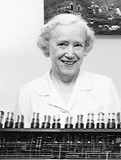- unknown (b.)
Bio/Description
An American author of children's books and books about the history of electronic computers. She began her undergraduate degree at Oberlin College on a competitive mathematics scholarship and transferred to the University of Pennsylvania in Philadelphia where she completed her B.A. in mathematics in 1944. During this period, she was employed as a computer at the University of Pennsylvania's Moore School of Electrical Engineering. She retired from full-time work after marrying Moore School lecturer Dr. Arthur Burks, a mathematician who served as one of the principal engineers in the construction of the ENIAC, the world's first general-purpose electronic digital computer, built at the Moore School between 1943 and 1946. Unlike some of the Moore School women computers, she never worked directly with the ENIAC. At the conclusion of Arthur's work with the Moore School and at the Institute for Advanced Study in 1946, they moved to Ann Arbor, Michigan where he joined the faculty of the University of Michigan and helped to found the computer science department. She returned to school, earning an M.S. in educational psychology in 1957. Starting in the 1970s following the decision of Honeywell v. Sperry Rand, the federal court case that invalidated the ENIAC patent, she and husband Arthur championed the work of John Vincent Atanasoff, the Iowa State College physics professor whom the court had ruled invented the first electronic digital computer (a machine that came to be called the Atanasoff?Berry Computer) and from whom the subject matter of the ENIAC was ruled to be derived. In articles and two books, the first co-authored with Arthur, she sought to bolster the judge's decision and highlight testimony and evidence from the case. This pitted the Burkses in a deeply acrimonious controversy against exponents of ENIAC inventors John Mauchly and J. Presper Eckert. In Turing?s Cathedral by George Dyson it is noted that she, along with her husband, published the definitive Who Invented the Computer? in 2003.
-
Gender:
Female -
Noted For:
One of 75 females employed as a “woman computer” (a person performing mathematical calculations, before electronic computers became commercially available) and Co-publisher of the definitive “Who Invented the Computer?” in 2003 -
Category of Achievement:
-
More Info:


